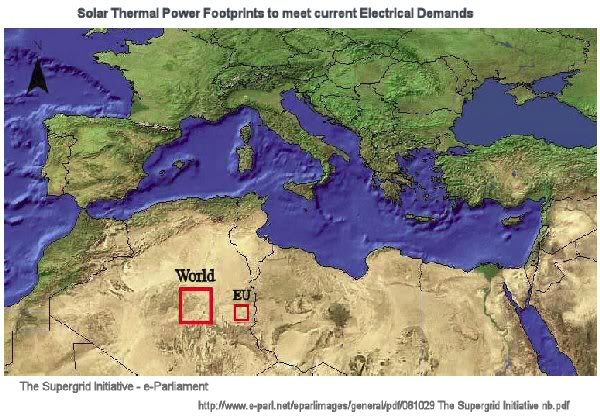Globally, the best renewable resource is solar energy. [...] Every year each square kilometre of hot deserts [in North Africa] receives solar energy equivalent to 1.5 million barrels of oil.
[...]
Solar factories can tap into this using concentrated solar power (CSP) plants [which] use mirrors to concentrate sunlight to create heat which is used to raise steam to drive steam turbines and electricity generators. An area of just 127km x 127km covered with CSP plants would produce as much electricity as Europe is using now.
Two German scientists, Dr Gerhard Knies and Dr Franz Trieb, calculate that just 0.5% of the world’s hot deserts, if covered with CSP plants, could generate as much electricity as the world now uses.

Okay. Pause for a second. The sun is burning millions of miles away from the Earth and just giving us its energy whether we like it or not. Before now, deserts were of use to very few living organisms. Humans have figured for the first time how to take advantage of these vast expanses.
Quick math:
- 1 sq. kilometer of the Sahara Desert receives as much energy (in the form of sunlight) in the course of a year as is contained in 1.5 million barrels of oil
- The Sahara Desert is about 9 million sq. kilometers
- 9,000,000 sq. kilometers X 1,500,000 barrels of oil per sq. kilometer = 13,500,000,000,000 barrels of oil
- Every year, the Sahara Desert receives sun-light energy that's the equivalent of 13.5 trillion barrels of oil
- FYI: That's way more than the 7.3 billion barrels of oil used every year in the US
The Supergrid itself is planned to be a web of High Voltage DC lines that stretch over thousands of miles -- at some points, even underwater. It would interconnect different areas of Europe and North Africa, and the majority of power would be supplied by solar energy from the Sahara, however every different geographic region in the web would contribute its own form of renewable energy (eg coastal countries would contribute energy from wind turbines).

What makes the Supergrid plan attractive is the use of 1) Concentrated Solar Power (CSP) plants to produce the energy and 2) DC lines to transport the energy.
Concentrated Solar PowerThe plan has been proposed by a group called E-Parliament. Spain, Morocco, Algeria, and Egypt are already beginning to lay the groundwork, and there has been support from leaders in France, Germany, and the Netherlands. The former U.S. Vice President Al Gore has also spoken in support of the plan.
This refers to a way of converting sunlight into electricity by reflecting it off curved mirrors (parabolic mirrors to be precise) toward a liquid to heat it up and eventually boil water (which in turn spins turbines that make an electric current). It is a technology that is in its last stages of development and already produces more energy than other renewable sources.
DC Power Lines
I don't want to go too far into the difference between AC (Alternating Current) and DC (Direct Current) power, though you should know that (more or less) all power lines in the world are AC. (And I'd like to point out that when you plug an AC/DC converter into a wall socket, it takes the AC electricity from the power lines and converts it into DC electricity because for whatever reason your electronic device requires it.)
What's important for the Supergrid is that AC is works well for carrying electricity over distances that are less than a few hundred miles -- and therefore all the power lines in our country were built as AC -- however DC is better when you want to carry electricity over thousands of miles. That means, unfortunately that a whole new set of DC power lines will need to be built across Europe.
Right now, there is one CSP plant in the United States -- called the Solar Energy Generating Systems (SEGS), which is in California's Mojave Desert. There used to be another one -- called Solar Two, also in the Mojave -- but it was shut down in 2001. The vast majority of the US's electricity is produced by burning fossil fuels -- including coal, natural gas, and oil -- which produce tons of carbon emissions annually.
But there's still hope! Whenever you hear Obama talking about the need to update our nation's infrastructure, this is one of the things he's talking about. If America ever wants to employ a green system like the Supergrid, we need to build new power lines first. Then, in time, we may build larger and larger CSP plants that could power the whole US. We're on the cusp of a new world of energy.
No comments:
Post a Comment